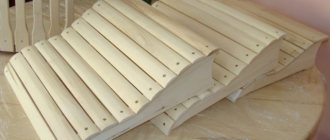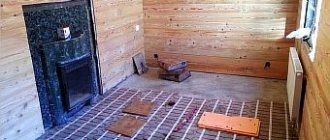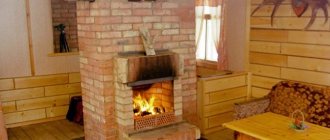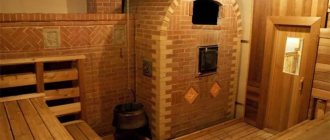It is impossible to imagine a bathhouse, especially a Russian one, without a steam room, and the steam room must have a heater, which is the simplest steam generator. The main function of a steam generator is to convert water into steam, and it is to solve this problem that a sauna stove with a steam generator exists.
Currently, industry and self-taught craftsmen produce a large number of models of steam generators for baths of various types (Russian, Finnish, Ofuro, etc.), differing in their design, purpose and method of generating steam.
Why does a Russian bath need a steam generator?
Oven with steam generator
A distinctive feature of the Russian bathhouse from other types of bathhouses is that it is thanks to the “light steam” obtained by pouring water (infusions of herbs) onto hot stones that the resulting steam is not only a means of heating the air in the steam room, but also serves as a disinfectant and health-improving agent .
Water, passing from a liquid state into a vapor state, releases a large amount of heat, while the warm air rises, which allows the person taking water procedures to warm up gradually, rising from the floor level to the canopy located above.
The steam obtained by using decoctions of medicinal herbs is therapeutic, while the inhalation effect occurs unnoticed by the main purpose of the bath, the adoption of sanitary and hygienic procedures.
Previously, the Russian bathhouse was heated “black” and the simplest steam generator was stones placed around a boiler with water, under which a fire was built.
A modern Russian bathhouse is heated “white” and a heater acts as a steam generator, which is heated not by open fire, but by heating the stones with waste gases from the burned fuel and structural elements of the stove.
In addition, steam generators are used to produce steam, operating from an AC electrical network and differing in the method of heating water (induction, electrode, using heating elements).
Additional criteria
If you are serious about choosing a sauna stove, pay attention to additional parameters that may affect the convenience and performance of the unit:
- The volume of the heater determines the number of stones that can be used during bath procedures. The fewer stones, the faster they will warm up, but also cool down faster. This parameter should be assessed individually - if you do not plan to wash and steam for a long time, choose models with a small heater volume.
- Type of heater - open or closed. In the first case, the air in the sauna will heat up faster, and the steam will be more aggressive. A closed-type heater is considered gentle, emitting soft, comfortable heat - the stones here are covered with metal walls, gratings or meshes.
- The source of steam is traditional and forced. In order to create steam in a conventional sauna stove, it is necessary to water the stones from time to time. But with this method it is difficult to control the level of humidity and achieve a comfortable microclimate. In devices with forced steam generation, an additional element is provided - a steam generator, which allows you to control humidity. It heats up faster than stones, saturating the space with the necessary steam while maintaining a comfortable air temperature.
- Efficiency and heating rate. The metal stoves included in this rating are characterized by accelerated heating - they reach maximum temperature parameters in an average of 30 minutes. The heating rate is also affected by the capacity of the firebox, the volume and type of heater - we mentioned above how to choose a stove for a sauna according to these criteria.
When choosing a stove for a sauna or bathhouse, first of all take into account the dimensions of the steam room for which you are purchasing the unit.
Then consider the design features - the location of the firebox, the presence of a heating tank, a steam generator, the type of heater. Don’t forget to inquire about the heating speed and fuel consumption - the device must be highly energy efficient. Return to list of articles
Types of steam generators and their design
Connecting pipelines for water and steam
Currently, in addition to the stones traditionally used in Russian baths to produce steam, electric steam generators are used, which come in 3 types, these are:
- Electrode - heating occurs by passing an electric current through water.
- Induction - water is heated by high frequency currents,
- With the help of heating elements (heating elements) - when electric current passes through the elements of heating elements, they heat up and transfer their heat to the water in which they are immersed.
The steam generator consists of the following structural elements:
- The housing in which all other structural elements are placed. Can be made of metal or durable plastic.
- Water storage tank.
- Vaporization chamber (block).
- Control and safety unit.
- Connecting pipelines for water and steam.
- Electric wires.
- Automation and control devices.
- Water and steam supply pumps.
The control unit includes sensors for monitoring the water level in the storage tank and the amount of steam generated at the outlet of the steam generation unit.
The safety unit contains automatic circuit breakers for protecting electrical circuits and heating elements from short circuit currents and voltage entering the steam generator housing. The presence and volume of security and automation systems, as well as water and steam supply pumps, are individual for each specific device model.
Content:
- Criterion No. 1: Thermal power
- Criterion #2: Fuel Type
- Criterion No. 3: built-in water heating tank
- Criterion No. 4: firebox location
- Additional criteria
The rating of sauna stoves is increasingly topped by metal structures - they meet the requirements of ergonomics, efficiency, safety and optimal thermal performance. The devices will create an ideal microclimate, heat the stones, saturate the air with moisture and, depending on the design, provide hot water to sauna visitors. The Garden Assistant experts know which stove to choose and install in the bathhouse - you will find important tips on purchasing equipment in this material. Let's go through the main criteria that need to be taken into account when studying popular models on the market.
Features of the operation of a furnace with a steam generator
The operation of a stove equipped with a steam generator involves adjusting the humidity and air temperature in the bathhouse by changing the amount of steam supplied.
The operation of a steam generator of a modern design is carried out as follows:
- water is poured into the storage tank automatically or manually, which depends on the model and configuration of the steam generator,
- from the storage tank, through connecting pipelines, water enters the steam generation chamber,
- in the steam generation chamber, under the influence of high temperature, water passes from liquid to gaseous state,
- steam enters the steam room through special openings.
The process of steam generation in different oven models may vary, which is due to their design and the type of heating of the steam-generating chamber.
Advantages
An excellent solution when arranging a sauna is to purchase an electric stove equipped with a heat exchanger. This unit has many advantages, among which the following qualities are worth noting:
- modern appearance;
- compactness;
- a light weight;
- multifunctionality;
- setting up automatic control;
- quiet operation;
- ease of installation;
- efficiency of heating and steam creation;
- safety;
- reasonable relationship between price and quality;
- wide variety of models.
Pros and cons of installing steam generators
Steam generator for the bath
The presence of a steam generator that does not operate using an open fire produced by burning fuel, but by converting electrical energy into thermal energy, allows the use of such devices not only in a separate bathhouse, but also in a modern apartment.
The advantages of modern steam generators are:
- the heating time of the steam generator does not depend on the heating state of the stove in the steam room (heating up stones in a stove when burning wood),
- operation does not require the installation of an exhaust pipe or the presence of a heating furnace. Can be used in an apartment complete with an electric heating stove,
- it is possible to regulate the temperature and amount of steam supplied,
- small geometric dimensions and weight allow use in rooms with a small area,
- Short periods of time for heating water and starting use from the moment it is turned on, allow you to reduce the cost of used electrical energy,
- The presence of security and automation means makes it possible to secure the use of devices and ensure their operation in automatic mode.
The disadvantages of steam generators of this type include:
- dependence of work on the availability of power supply networks,
- high price.
Criterion No. 4: firebox location
According to this parameter, all heaters are divided into two groups:
- with remote firebox;
- with built-in firebox.
In the first case, the fuel storage tank has an elongated design, which allows you to place the firebox in an adjacent room and load firewood from the dressing room, shower room or washing room. The advantages of models of this type are that the steam room itself remains clean and there is more space for visitors.
In units of the second type, the firebox is integral with the stove body, so you have to heat the heater directly from the steam room. This is a less practical, but more authentic solution - stoves with a built-in firebox create a real sauna atmosphere, allowing you to simultaneously admire the burning logs.
Important! When choosing a heater with an external firebox, do not forget to measure the thickness of the walls in your steam room and compare it with the length of the tunnel.
Cuirassier 10 Finka
Specifications:
- steam room volume – from 6 to 12 m3;
- fuel – solid, firewood or pellets;
- the door is solid without glass;
- firebox material – steel;
- firebox type – built-in;
- heater type – open;
- weight of stones – 45 kg;
- net weight of the product is 57 kg.
Cost – 13,326 ₽.
Product link: https://sadpom.ru/products/drovyanaya-pech-kamenka-kirasir-10-finka/
The compact heater is ideal for small steam rooms. The device is designed like a Finnish stove - you can put firewood into the firebox directly from the steam room, which is fully consistent with Finnish sauna traditions. The quality of fuel combustion is improved by heating the air entering the firebox, and the temperature of the exhaust gases is used to heat the stones. Despite its small size, the Cuirassier 10 Finka has a spacious firebox, so you don’t have to worry about it being cold in the steam room - the pleasure of visiting the sauna is guaranteed!
Advantages of the model:
- quick heating of the steam room;
- high-quality steam due to the large mass of stones;
- compact dimensions;
- low fuel consumption;
- democratic price.
Flaws:
- effective only in small steam rooms.
Back to Contents
Choosing a furnace with a steam generator
When choosing a stove equipped with a steam generator, as well as a separately installed device, the criteria determining the choice of device will be:
- Purpose.
This indicator determines what type of bath the steam generator is intended for (Russian, Turkish, Japanese, etc.).
- Electric power.
- Dimensions.
- Degree of protection (IP) against water and moisture.
- Availability of an automation system (water collection, steam generation, cleaning the surface of the tank and steam-generating unit).
- Availability of additional options (steam aromatization, control of lighting in the steam room, etc.).
- Manufacturer's brand.
- Price.
Various models of steam generators are produced for inclusion in electrical networks of different voltages (single-phase, three-phase), so when choosing a device you need to pay attention to this indicator.
Choosing a steam generator oven
When choosing a sauna stove with a steam generator, you should not forget about the fundamental characteristics of the equipment, on which the quality of heating your room will depend.
Power is what you need to pay attention to first. You can independently calculate the required power of a stove for a bath with a steam generator. A formula has been drawn up for this: for a room volume of up to 10 m³, it is necessary to select equipment based on power, taking into account 1 kW/m³.
When the steam room is quite large in volume, another calculation is taken as a basis - 0.8 kW/m³. Making a similar power calculation is very simple. But it is worth understanding that this formula should be used only in cases where the bathhouse is well insulated, there is a high-quality vapor barrier and a ventilation system. If the steam room has a window, a glass door, or one or two external walls, then the power of the device should be even greater, about one and a half times.
It is also worth mentioning the operating voltage of a sauna stove with a steam generator - this is also an important point when choosing a heating device. There is a certain relationship between power characteristics and voltage. If the power indicator is above 7 kW, then it is worth connecting the unit to a 380 Volt power supply. For less powerful stoves, a 220 Volt network is suitable.
In case of periodic interruptions in the electrical network, it is necessary to use a backup power system or voltage stabilizers. If you ensure stable operation of the electrical network, you will thereby contribute to the long service life of your furnace equipment.
And another important factor that requires attention is the volume of loaded stones. Additional functions such as sounding a sound when there is no liquid in the steam generator tank and aromatizing the steam will make using the steam room easier, while simultaneously creating the necessary pleasant atmosphere in it.
Installation requirements and security controls
Ventilation system connector
Requirements for installation and safe operation are reflected in the operating instructions included with the steam generator, and the general criteria that ensure such modes are:
- Electrical wiring must be designed for the power of the connected device.
- The steam generator must be grounded.
- The device must be connected to the electrical network in a separate group through an individual protection device (circuit breaker).
- The room where the steam generator is installed must be dry and equipped with a ventilation system (natural or forced).
- The length of the steam line (from the device to the steam room) should be as short as possible.
- The location of the steam line in relation to the entry into the steam room should be such that there are no places where moisture accumulates (condensation) that impedes the passage of steam.
Design features that you must observe when building a sauna stove
As mentioned above, stoves can be metal or brick, and their designs differ from each other. To understand which one will be more convenient for installation in a particular room, you need to consider both so that you can draw the right conclusion for yourself!
Metal oven
Metal sauna stove with water tank
Cast iron and steel versions of wood-burning sauna stoves have the same design, and their installation can be done in two ways, depending on their design:
- the firebox is located in the dressing room, and the heater is in the steam room;
- The firebox and heater are located in the sauna room.
The first option is preferable, since in the steam room you can accidentally burn yourself on the firebox door. Along with the heater, a water tank is also located in the steam room.
This diagram shows the design of a sauna stove model, in which the firebox goes into the dressing room.
Construction of a wood-burning metal sauna stove
- This oven is equipped with a water dispenser. It is convenient in that you do not need to constantly add liquid to the heater - water or broth, it will gradually flow in the specified amount. It is shown in the diagram as number one.
- At number two in the diagram there is a heater covered with a water dispenser, which, when heated, will give out the gift for a long time. Due to the fact that a metal stove cools down quickly, a closed heater will be a good help for retaining heat.
- A chimney pipe passes through the heater from the firebox. Its location also helps to retain heat near the stones.
- On the other side of the pipe there is the second part of the heater - already open. Water from the dispenser, passing through the closed chamber of the first heater and under the pipe, exits through the open heater in the form of dry steam.
- The deep and voluminous firebox, made of heat-resistant steel, has a chrome finish.
- The firebox contains a cast iron grate, which takes a long time to cool down, which means it also retains the heat from the fuel.
- Under the firebox there is an ash pan chamber with a drawer. Waste from burning wood is collected there, and it must be cleaned after each heating of the stove.
- An exhaust channel emerges from the firebox, having a certain length designed for the thickness of the wall through which it will pass. This model is made to be installed in such a way that the firebox door is in the adjacent room.
- A self-cooling door is installed on the combustion channel. It cools quickly due to the fact that it is located far enough from the combustion chamber.
- From the back of the firebox, through which it exits into the steam room, there is a secondary air supply channel.
- On the front of the case, on the side that will be near the wall on the steam room side, a convector casing is installed, which allows the heated air to escape upward and not into the wall.
- A chimney is placed on the pipe that passes through the heater.
- A water tank is installed on the chimney, operating on the principle of a samovar. The heated pipe inside it will serve as a good heat exchanger. The tank can be filled with water manually, or it can be connected to a water supply.
Convenient water heating tank
- Next, a chimney pipe riser is placed on the tank nozzle, which is passed through the ceiling and roof. When passing through flammable floor materials, the chimney must be insulated with non-combustible materials. The thickness of the insulator should be 7-10 centimeters greater than the thickness of the ceiling and extend towards the attic. The distance between the ceiling and the pipe should be 10-15 centimeters, filled with non-flammable insulator. Sometimes a box is used to lay or fill the insulator.
- Waterproofing must be installed around the head of the pipe on the roof so that moisture cannot penetrate into the attic and damage the wooden elements of its structure.
To install a metal stove, you need to properly prepare the place - it should be a non-combustible area made of brick, concrete or ceramic tiles and a brick wall through which the combustion channel will pass.
Approximate installation diagram of a metal stove in a sauna
The furnace installation diagram looks approximately as shown in the figure. Minor adjustments are possible, for example, if the stove is installed on a brick or concrete podium.
How to make a homemade steam generator for a bath with your own hands
You can make a steam generator for a bath with your own hands; the choice of its design and method of generating steam depends on the personal preferences of the user, as well as the type of bath and its geometric dimensions.
The simplest and most traditional way is to build a steam generator directly in the structure of the sauna stove.
- A sauna stove-heater operating “white” is equipped with a compartment in which stones are placed. The furnace body is made of metal or brick, and the water storage tank and the compartment with stones are made of metal.
- When burning wood or other fuel, stones heat up, and steam is generated when water is poured over them. The more stones are used, the more steam can be created once they are fully heated.
- When deciding to make a separately installed device, you will need a sealed vessel (cylinder, tank, etc.) capable of withstanding the steam pressure generated when heating water in a confined space. These can be used gas cylinders for various purposes (oxygen, carbon dioxide, argon, etc.) after their special treatment (venting residual gases and washing), as well as specially welded containers of the required sizes.
- Holes are cut in the vessel for installing and securing heating elements, cold water supply and steam outlet pipes, as well as for installing pressure and temperature control devices (pressure gauge, thermometer, thermocouple, etc.) and safety devices (check valve and safety valve).
- The heating elements are cut into the bottom of the vessel (cylinder) in such a way that they are located in a plane parallel to the ground level, in order to prevent their damage when the water level in the vessel drops below the permissible level. The steam outlet pipe is installed in the upper part of the vessel, and the water supply pipe is installed in the lower part of the device.
- A check valve, a water filter and a shut-off valve are mounted at the inlet to the steam generator, and a pressure gauge and a shut-off valve are installed at the steam outlet pipe. A safety valve and sensors for controlling water level and temperature are installed in the upper part of the steam generator.
- To connect to the electrical network and operate the device in automatic (semi-automatic) mode, an electrical circuit is assembled. Operation control can be based on the use of electronic equipment (controller) or through the installation of magnetic starters.
- When using magnetic starters, temperature and pressure sensors are switched on in their control circuits, turning off the heating elements when the specified parameters (temperature, pressure) inside the unit are exceeded.
- When using a controller, these parameters are monitored automatically. In this case, it is possible to perform more precise adjustment of the operating modes of the steam generator.
A sauna stove equipped with a steam generator allows not only to create an optimal microclimate in the steam room, ensuring a pleasant experience of health and sanitary procedures, but is also a guarantee of health all year round, regardless of the region and place of residence of the user of such a device.
Getting to know some models
Below is a rating of the most commonly purchased stoves with a steam generator. All options are considered in ascending order of their cost.
The wood-burning device with a heat exchanger " Konvetika " is produced in Russia. Its price is 13.5 thousand rubles. This stove weighs almost 85 kg and with dimensions 640x430x965 mm (WxDxH) is capable of heating a room with a volume of 18 cubic meters. meters.
The curved frame and the absence of screws on the side panels are distinctive features of the device’s appearance. Thanks to a special cast-iron door, you can build a kind of fireplace from the stove, near which it is pleasant to sit and watch the flames. For the manufacture of this model, a fairly durable material with a thickness of at least 4 mm was used. An open type heater can load up to 85 kg of stones.
Due to the fact that the heat exchanger is located at the very bottom of the unit and produces hot steam of high dispersion, the wood-burning stove heats up quite quickly. The advantages of the design also include the presence of supply channels and a special pubis, which help fill the steam generator with water. Thanks to the holes in the oven, cleaning the device is effortless.
SAWO Mini Combi MNC NS unit is made in Finland. Its cost is 15 thousand rubles. The compact 3 kW stove is equipped with a steam generator, perfect for heating small baths and medium-sized saunas. In general, this model with dimensions of 330x210x450 mm is capable of filling a room with a volume of up to 4 cubic meters with steam. meters. The heater can easily accommodate up to 10 kg of stones.
Small size and low power determine the main advantage of foreign-made furnaces - relatively low cost. In addition, the body of the device and the stone compartment are made of high-strength stainless steel. Galvanized steel is used for the internal filling of the furnace. The ability to add aroma oil to a bowl specially built into the unit is another noticeable feature of the Finnish stove. If the steam generator, which can hold up to 5 liters of liquid, runs out of water, the user is notified about this using a special function.
The Vega Combi Automatic BC60SEA oven is a product of the Finnish company Harvia . The heater is completely easy to operate and runs on electricity. The cost is set at 22.5 thousand rubles. The compact device weighs only 15 kg and has the following parameters: width – 480 mm, height – 540 mm, depth – 310 mm.
Up to 20 kg of stones can be placed in a furnace, the power (6 kW) of which is enough to heat 14 cubic meters. meters of bath room. The electric device is equipped with a steam generator, which can be independently controlled in order to coordinate the direction of heated moist air and achieve the optimal temperature in the bath.
Durable stainless steel is the main material used to make the electric heater. This choice of the manufacturer guarantees high reliability and durability of the device. Thanks to its stylish appearance and compact size, the unit will fit perfectly into any room. The stove with heat exchanger Harvia Vega Combi is an excellent model that skillfully combines the functions of a stove and a steam generator.











